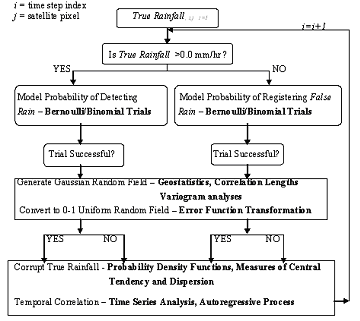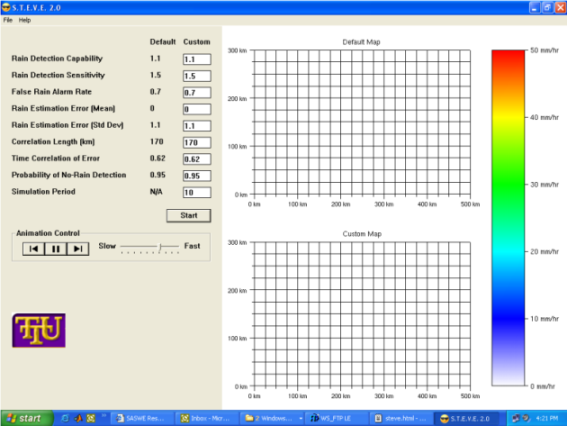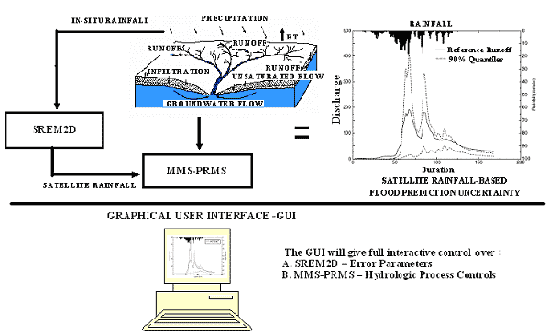Steve
Stochastic Theory Education through Visualization Environment- STEVE
Introduction
This area of research focuses on curriculum development, instruction and enhancing learning in the undergraduate/graduate classroom. We are currently exploring visualization-based techniques to improve the current state of learning in the classroom of stochastic theory in hydro-meteorology. As our first indigenously built GUI tool, this page describes the history and evolution of STEVE – Stochastic Theory Education Through Visualization Environment.
TIMELINE OF STEVE EVOLUTION:
Summer 2008: STEVE 2.0 successfully completed by Robby Florence (TTU Computer Science Major- Class of 2008) using openGL. Faster visualization, removal of all major bugs and improvement of user-friendliess achieved.STEVE 2.0 is published in Computer Applications in Engineering Education.Download paper
Spring 2008: NASA New Investigator Program awards SASWE Group Leader Dr. Faisal Hossain a grant involving an education component to improve and implement STEVE 2.0 for outreach and education activities.
Spring 2008: Engineering Development Friends (EDF) Endowment (from the Dean’s Office – College of Engineering) selects a STEVE proposal for funding. Funding is provided by EDF to upgrade STEVE 1.0 to STEVE 2.0 and make it ready classroom implementation.
Fall 2007: Survey of curricula of stochastic theory education in water resources engineering completed and published in Computer Applications in
Engineering Education.Download paper
Spring 2007: Presentation on national survey of stochastic theory and STEVE 1.0 prototype presented at American Society of Engineering Education (ASEE)
Southeast Regional Conference in Louisville, KY.Download ASEE presentation
Fall 2006: Prototype on STEVE 1.0 developed by TTU Computer Sciences Majors using Java Native Interfacing. Proof of concept successful, but certain visualization bugs remain.
Spring 2006: Idea of STEVE and the need to improve stochastic theory education floated by SASWE Group Leader to the community.
DOWNLOAD S.T.E.V.E. VERSION 2.0:
Software:Download STEVE 2.0 Application
Installation Instructions: 1) Save zipped folder ‘STEVE20.zip’ in your local (windows) drive; 2) Unzip the folder; 3) Look for ‘STEVE.exe’ that shows as a smiley icon; 4) Double click this ‘STEVE.exe’ icon; 5) Create a short-cut on desktop if necessary.
Source Codes: Download STEVE 2.0 Source Codes
HISTORICAL BACKGROUND OF STEVE
Stochastic theory is a very important subject matter in any engineering discipline. It describes the omni-present uncertainty in man-made or natural systems and further helps us to mathematical model it. Thus, most engineering curricula at the have some element of stochastic theory delivered as learning objectives. The emerging research contours on hydroscience indicate a fast evolution towards greater use of stochastic methods. This recognition therefore warrants prior knowledge of computational skills for the novice graduate research student. This consequently raises a major demand on the admission criterion for a graduate research program that entering students must be well prepared a priori on the computational aspects of stochastic theory for conducting independent research in the hydroscience area. Hence, in the current state-of-the-art, it becomes unrealistic to expect that entering graduate students will be adequately prepared to embark on advanced level research on hydrosciences involving computational applications of stochastic theory. The realization of the practical importance of stochastic concepts in modeling natural phenomenon in hydrosciences should therefore start early for the students in the undergraduate classroom. Unfortunately, most engineering university baccalaureate programs introduce students to these concepts only in the graduate level. Our recently concluded national survey of curriculum on stochastic theory in water resources engineering education indicate that 84% of all courses are graduate (ref: Schwenk et al. (2008) A Computer-Aided Visualization Tool for Stochastic Theory Education in Water Resources Engineering, Computer Applications in Engineering Education). This means that the diverse but foundational concepts making up stochastic theory, such as random variables and processes, probability density functions, moments, geostatistics, autocorrelation, random field generation, time-series analysis etc., can overburden freshmen graduate students unless particular care is taken in demonstrating these concepts via real-world examples employing computational tools. Conventional teaching paradigm for deliverng stochastic theory to model the variability of such natural systems continues to rest mostly on text-based pedagogy involving comprehensive stochastic theory books. While the traditional method is still needed, there is scope to make the subject matter more exciting and ‘learner-friendly’ by leveraging visualization technology. As Alice in her Wonderland said ‘..what’s the use of a book without pictures..?’
THE GENERAL CONCEPT BEHIND THE STEVE GUI
The improvement in learning that we hope to deliver to students in the classroom will be achieved on the basis of a space-time stochastic model to generate satellite rainfall and a user-friendly Graphical User Interface (GUI) that connects the stochastic model to hydrologic modeling tools. The stochastic model, SREM2D, being rich in application of wide ranging concepts of stochastic theory, is considered an ideal medium to translate stochastic theory to problems on modeling variability of systems that may arise in a student’s future professional work. The GUI would provide full interactive control to students to couple the satellite rainfall stochastic model with hydrological models of varying levels of complexity and observe independently the corresponding stream-flow simulation graphically.

Figure 1. Schematic of SREM2D showing application of stochastic concepts in space-time corruption of rainfall.
The GUI, aptly named Stochastic Theory Education through Visualization Environment, STEVE, has already being prototyped and is currently undergoing upgrade (from version 1.0 to 2.0)(see Figure 2 below).

Figure 2. The GUI on STEVE 2.0 – for computer assisted instruction scheme on stochastic hydrology. STEVE 2.0 integrates SREM2D in a user-friendly GUI to provide easy and rapid visualization of rainfall fields according to certain stochastic theory concepts by the students. Students can thus observe the effect of their imposed change to a stochastic parameter and prove/disprove hypotheses set up by them while learning theory
STEVE 2.0 will also allow/challenge students in the class room to pose science questions of their own and consequently attempt to seek answers independently in an active learning format. In addition, the GUI will solidify learning of concepts on: (1) probability distributions of discrete/continuous variables associated with Monte Carlo error propagation; (2) spatio-temporal dependency of natural variables; (3) random field generation; (4) scaling issues; (5) the connection to theoretical derived distribution theory based on analytical
approaches. After a thorough testing of the GUI, STEVE 2.0 is planned for integration into the following three courses taught in the CEE Department of TTU: (1) CEE6430- graduate Probabilistic Methods in Hydrosciences course; (2) CEE6440 – graduate Hydrometeorology; and (3) CEE 5420 -undergraduate (senior) Engineering Hydrology
(for details see “Teaching”).
Through such an end-to-end system involving the GUI and SREM2D we expect to create an ideal medium for students to translate stochastic theory to problems that may arise in a student’s future professional work.
LONG TERM VISION ON STEVE GUI
A long term vision with STEVE is to leverage it for improving the current state of learning in the classroom of the role of hydrologic process controls in satellite-based monitoring of flooding. We believe this is going to be an important topic to teach to future water resources engineers as global satellite missions for hydrologic monitoring become common from 2015 onwards (e.g. Global Precipitation Measurement; Surface Water Ocean Topography Mission; Soil Moisture Missions – SMAP/SMOS/HyDROS etc.) To achieve this learning objective, we require to couple STEVE to another GUI that embeds a modular hydrologic model. An existing Modular Modeling System (MMS) developed by the United States Geological Survey (USGS) is planned for use as the main hydrologic model GUI for this purpose. In long-term vision of the STEVE GUI, we hope to have a tool that can provide full interactive control to students to couple the satellite rainfall stochastic model with hydrological models of varying levels of complexity and observe independently the corresponding stream-flow simulation graphically. We plan to specifically target the Precipitation-Runoff Modeling System (PRMS) component of the MMS for the coupling of SREM2D. Very recently, a climate generator was coupled with MMS to evaluate the statistical properties of the climate time series as well as the resulting stream-flow hydrographs from PRMS on the basis of 100 ensembles (personal communication with Dr. Leavesley in 2006). This clearly indicates that the future vision on STEVE is technically feasible (see Figure 3 for a schematic example).

Figure 3. Long term vision on STEVE – for computer assisted instruction scheme on stochastic hydrology and the role of process controls in flooding. Future STEVE will integrate SREM2D and PRMS modules on a user-friendly computer system.
ACKNOWLEDGEMENTS
Support for the development of STEVE is provided by a number of sources as follows: 1) Department of Civil and Environmental Engineering (TTU); 2) Engineering Development Friends Endowment 2008; 3) NASA New Investigator Program Award 2008-2011; 4) Dr. Donald Visco, Department of Chemical Engineering (TTU)(on designing online surveys; 5) Dr. Ambareen Siraj, Department of Computer Science (TTU).












